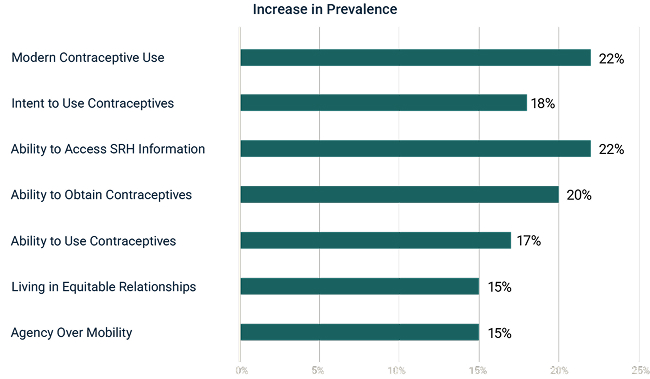The Impact of Community Support for Gender Equality on Young Women’s Economic Outcomes in Nigeria and Kenya

The latest research from the Gender Norms Data Engine, which combined nationally representative survey data with Fraym’s machine learning-derived ward-level estimates, highlights a critical but often overlooked driver of adolescents’ and young people’s health: gender-equitable social environments.
In both Nigeria and Kenya—with stronger evidence emerging from Nigeria—the data suggest that young people aged 15–24 who perceive more equitable gender norms, or live in communities that reflect such norms, are more likely to pursue, or feel supported to pursue, their sexual and reproductive health (SRH) goals.
These findings point to an important consideration for programs, policymakers, and donors: improving SRH outcomes may require attention not only to service delivery and products, but also to the broader social environment—including the gender norms or the shared beliefs and practices that shape young people’s ability to seek care, access resources, make informed decisions, and feel supported in doing so.
We found clear and consistent evidence in both Kenya and Nigeria: gender-equitable norms are strongly linked to better SRH outcomes for young people. In Nigeria, adolescent girls and young women (AGYW) living in communities with more equitable gender norms are more likely to use modern contraception and to express greater intentions to use it. Among adolescent boys and young men (ABYM) in both countries, more equitable gender norms were associated with increased intent to use contraception, though this did not consistently translate into current use.
What’s even more encouraging is that these norms don’t just influence behaviors—they help create the enabling conditions young people need to thrive. Across both Nigeria and Kenya, equitable gender norms were significantly and positively associated with improved access to SRH information, greater ability to obtain and use preferred methods, and—especially for AGYW—more freedom of movement and fewer experiences of controlling partnerships.
A particularly novel insight from this analysis is the powerful role of collective norms—shared beliefs and practices among peers and communities, which often exert an even stronger influence on behavior than individual beliefs. This effect was especially pronounced in Nigeria, where adolescent girls and young women demonstrated clear gains in contraceptive use and intention when community-level support for gender equitable norms was higher.
To explore the real-world potential of shifting gender norms, we ran simulations to ask: What if communities became just a bit more gender-equitable? Using a 10-point increase in the G-NORM score—our composite measure for gender-equitable norms—we modeled how key SRH outcomes for Nigerian AGYW might change.
The results were striking. Even a modest shift towards gender-equitable norms in a community may lead to significant improvements (Figure): a 22% increase in AGYW using modern contraception and an 18% increase in those intending to use it.
Gains extended beyond behavior—22% more AGYW reporting ability to access SRH information, 20% more reporting ability to obtain their preferred method, and 17% more reporting ability to use it. Relationship dynamics could also improve: 15% more AGYW would report freedom of movement, while 15% fewer would experience controlling behaviors from partners.
A 10-point increase in gender-equitable norms (G-NORM score) could boost modern contraceptive use among Nigerian AGYW by an additional 22%.
These projections make a compelling case for integrating norm-shifting strategies into SRH programs. Gender-equitable norms aren’t just theoretical—they are actionable, measurable, and, with the right intervention, can be transformative.
Figure: Estimated Impact of a 10-point increase in G-NORM Score on Select SRH Outcomes among Nigerian AGYW (ages 15-24)

Gender norms are a powerful, yet often overlooked, lever for improving sexual and reproductive health. Our findings show that when communities support more equitable norms, young people—especially AGYW—are more likely to access SRH information, use contraception, and experience healthier, more autonomous relationships. While the analysis cannot establish causality, the strength and consistency of the associations across diverse outcomes and contexts suggest that gender norms likely play a meaningful role in shaping the social and structural conditions that support positive SRH outcomes.
But norms don’t shift in isolation. Our findings highlight the importance of changing not just individual beliefs, but the collective beliefs that shape how young people live, move, and make decisions. This calls for investment in scalable strategies, such as school curricula, community mobilization, faith-based outreach, and media platforms, that can shift collective norms and sustain them over time. Programs that pair these strategies with youth-friendly SRH services offer a powerful, holistic approach to improving outcomes and expanding choice for young people.
With tools like the Gender Norms Data Engine, we now have the ability to turn insight into action. GNDE’s unique combination of population-level data and local granularity enables the design, targeting, and scaling of norm-shifting interventions in ways that were not previously possible.
The moment to invest is now, so that young people have the freedom, support, and tools to shape their health and futures.
To learn more about how norms shape SRH outcomes for young people and our methodology, please refer to the full report.